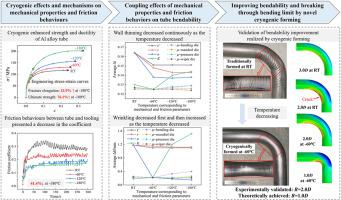International Journal of Machine Tools and Manufacture ( IF 14.0 ) Pub Date : 2023-12-26 , DOI: 10.1016/j.ijmachtools.2023.104111 Hong Sun , Heng Li , Heng Yang , Jun Ma , Xuancheng Hao , M.W. Fu

|
Aluminium alloy (Al-alloy) tubes, especially large-diameter thin-walled tubes with a tough bending radius, have been widely utilised in different industrial clusters owing to their high strength-to-weight ratio and good corrosion resistance. However, achieving such extreme specifications is challenging because severe and nonuniform bending deformation may cause tension and compression instabilities, such as overthinning, cracking, and wrinkling. Considering possible improvements in mechanical properties and friction behaviours of Al-alloy at cryogenic temperature (CT), the cryogenic bending potential of the 6061-O tubes with an extreme ratio of D/t of 89 (diameter/wall thickness) was explored at different deformation temperatures, including room temperature (RT) 20 °C, −60 °C, −120 °C, and −180 °C. First, the cryogenic mechanical properties and friction behaviour of the tubes were characterised. It was found that the overall mechanical properties of the Al-alloy tube were improved because of sub-grain formation and a more uniform distribution of dislocations at CT. The coefficient of friction between the tube and tooling exhibited a varying degree of reduction owing to the sensitivity of the tubes and the lubricant to CT. Subsequently, an innovative experimental platform for cryogenic bending was designed, and a finite element model of cryogenic bending was established. Third, cryogenic tube bendability and mechanism were explored. It was found that 6061-O tube formability can be effectively improved by cryogenic bending; however, there is no monotonic relationship between the bendability improvement and temperature decrease. The temperature to obtain the best bendability is −60 °C, at which the average wrinkle height is decreased by 81.4 %, and the average wall thickness reduction rate is reduced by 23.8 %. The bending limit represented by the bending radius is reduced from a 3.0D bending radius at RT to 1.0D at −60 °C, which is realised by the different or even opposite effects of the mechanical properties of tubes and the friction coefficient between the multiple contact interfaces on wall thinning and wrinkling.
中文翻译:

低温效应控制力学性能和摩擦行为突破铝合金管材弯曲极限
铝合金管,特别是大直径薄壁管,具有强弯曲半径,由于其强度重量比高、耐腐蚀性能好,在各产业集群中得到广泛应用。然而,实现如此极端的规格具有挑战性,因为严重且不均匀的弯曲变形可能会导致拉伸和压缩不稳定,例如过度薄化、开裂和起皱。考虑到铝合金在低温(CT)下机械性能和摩擦行为的可能改善,探索了D / t极限比为 89(直径/壁厚)的 6061-O 管在不同温度下的低温弯曲潜力。变形温度,包括室温(RT)20℃、-60℃、-120℃和-180℃。首先,表征了管的低温机械性能和摩擦行为。结果发现,由于亚晶粒的形成和 CT 上位错的分布更均匀,铝合金管的整体机械性能得到了改善。由于管子和润滑剂对 CT 的敏感性,管子和工具之间的摩擦系数表现出不同程度的降低。随后设计了创新的低温弯曲实验平台,建立了低温弯曲有限元模型。第三,探讨了低温管的弯曲性能和机理。发现低温弯曲可以有效提高6061-O管材的成形性能;然而,弯曲性能的提高和温度的降低之间不存在单调关系。获得最佳弯曲性能的温度为-60℃,此时平均起皱高度降低81.4%,平均壁厚减薄率降低23.8%。以弯曲半径表示的弯曲极限从RT时的3.0D弯曲半径降低到-60 ℃时的1.0D,这是通过管材的力学性能与多重之间的摩擦系数的不同甚至相反的作用来实现的接触界面的壁变薄和起皱。































 京公网安备 11010802027423号
京公网安备 11010802027423号